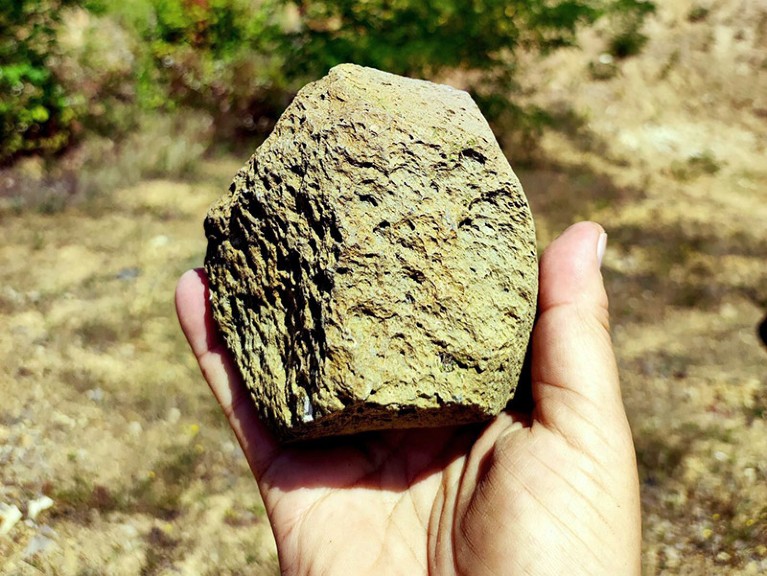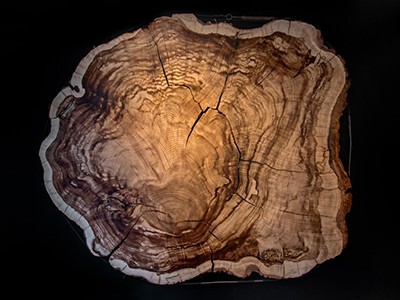[ad_1]

A stone tool from the archaeological site of Korolevo in western Ukraine.Credit: Roman Garba
Stone tools found in western Ukraine date to roughly 1.4 million years ago1, archaeologists say. That means the tools are the oldest known artefacts in Europe made by ancient humans and offer insight into how and when our early relatives first reached the region.
The findings support the theory that these early arrivals — probably of the versatile species Homo erectus — entered Europe from the east and spread west, says study co-lead author Roman Garba, an archaeologist at the Czech Academy of Sciences in Prague. “Until now, there was no strong evidence for an east-to-west migration,” he says. “Now we have it.”
Prehistoric sites documenting the presence of human ancestors in Europe before 800,000 years ago are extremely rare, says Véronique Michel, a geochronologist at the University of Côte d’Azur in Nice, France, who was not involved in the research. “This new study adds another piece to the puzzle [of] the dispersal of early hominins in Europe.”
The findings were published on 6 March in Nature.
Set in stone
The tools were discovered in the 1980s at the Korolevo archaeological site near Ukraine’s border with Romania, yet no one had been able to precisely date them.
Carbon dating, the archaeological workhorse, is getting a major reboot
To do so, Garba and his colleagues used a dating method based on cosmogenic nuclides — rare isotopes generated when high-energy cosmic rays collide with chemical elements in minerals on Earth’s surface. Changes in the concentrations of these cosmogenic nuclides can reveal how long ago a mineral was buried. By calculating the ratio of specific cosmogenic nuclides in the sediment layer in which the tools were buried, the team estimated that the implements must be 1.4 million years old. The dating analyses, Michel says, “appear highly reliable”.
Until now, the earliest precisely dated evidence of hominins in Europe comprised fossils2 and stone tools3 found in Spain and France. Both are 1.1 million to 1.2 million years old.
Intrepid travellers
The dates of the Korolevo tools lead the researchers to speculate that the human ancestors who made them were H. erectus, the only archaic humans known to have lived outside Africa about 1.4 million years ago. What’s more, the Korolevo tools resemble those found at archaeological sites in the Caucasus Mountains that have been linked to H. erectus and dated to about 1.8 million years ago, says Mads Knudsen, a geoscientist at Aarhus University in Denmark, who co-led the study. However, Knudsen adds, Korolevo’s most ancient layer of sediment didn’t yield any fossilized human remains, so it is impossible to say for sure that the tools were made by H. erectus.
Geographically, Korolevo lies between older archaeological sites at the intersection of Asia and Europe, and younger sites in southwestern Europe. The findings give a fuller picture of the direction of travel probably taken by the first Europeans, supporting the idea that they spread from east to west — perhaps along the valleys of the Danube River, Garba says.
Russia’s war in Ukraine is disrupting studies of ancient life
Korolevo is a treasure trove of prehistoric remains, says study co-author Vitaly Usyk, an archaeologist affiliated with the National Academy of Sciences of Ukraine in Kyiv, who visited the site last year with Garba for the first time since the Russian invasion of Ukraine in 2022. The Korolevo site is relatively safe and hasn’t been damaged during the war, although the area is now overgrown with vegetation, Garba says. “I can imagine doing fieldwork there even now.”
However, Usyk notes, few scientists can participate in field research at Korolevo or anywhere else in the country, because of travel restrictions or because they have fled the conflict. Usyk himself left Ukraine in 2022 and is now working at the Institute of Archaeology in Brno, Czech Republic, with a fellowship that allows him to continue doing his research. “Would I like to go back [to Ukraine]? Yes, of course,” he says. “I would like to organize expeditions to Korolevo to help other scientists reveal how ancient humans came from Africa to Europe.”
[ad_2]
Source Article Link



